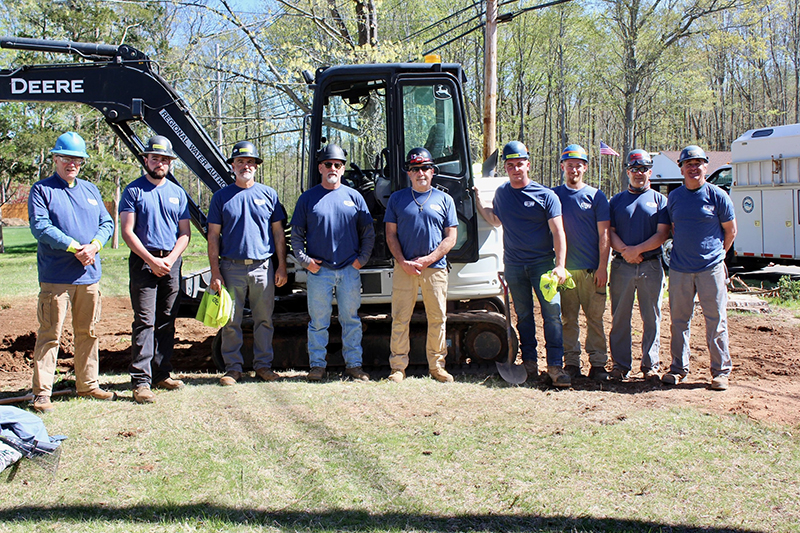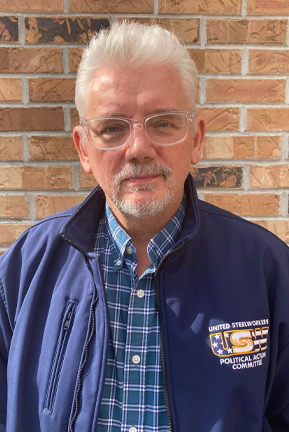
America’s Thirst
Simon and Barbara Hale dropped a small fortune on bottled water, battled rust-stained laundry and endured slimy showers before discovering the water from their well didn’t just taste, smell and feel awful but actually endangered their health.
The Vietnam veteran and his wife couldn’t afford the huge expense of connecting to the local water system, however, so about a dozen volunteers from United Steelworkers (USW) Local 12160 dug a trench, tapped the main and ran a service line into the couple’s home.
“It’s life-changing,” Barbara Hale said of the free work by the USW members, all of whom work at South Central Connecticut Regional Water Authority, noting she and her husband have clean, palatable water for the first time in years. “I just feel safe because we know there’s no question about what’s in it.”
President Joe Biden’s infrastructure program would deliver the same security to millions of other Americans thirsting for one of life’s basic necessities.
Among many other projects in his $2 trillion American Jobs Plan, Biden proposed about $110 billion in long-overdue upgrades to the nation’s patchwork of foundering water systems. The unprecedented investment will not only make life more convenient for consumers but protect their health and build stronger communities.
“It’s definitely time for somebody to take action,” said Local 12160 President Domenic DeDomenico, a water treatment operator at the authority who heard about the Hales’ plight and mustered the crew of Steelworkers who saved the couple thousands of dollars in connection costs.
DeDomenico and his authority co-workers proudly supply about 430,000 people via 1,700 miles of pipes in 15 municipalities. They treat, test and monitor the supply around the clock, distributing, on average, more than 42 million gallons of “perfect” water every day.
Many Americans long for that high level of quality and dependability right now.
In the authority’s own service area, for example, are residents who still lack access to public mains as well as the financial resources to connect to them. “Can you do that for us?” some of the Hales’ wistful neighbors asked the volunteers.
Across the country, ramshackle and disintegrating infrastructure delivers mere dribs and drabs of the clean, safe water Americans need every day.
Some families drink foul-tasting, smelly well water, like the Hales did before a recent test revealed traces of oil and other contaminants that required an urgent switch to the public water system.
Others travel dozens of miles to collect potable water each day because they live in areas with low water tables or because sewage or other pollutants foul the same streams or pipes used to source drinking supplies. Because of water quality and related problems in McDowell County, W.Va., for example, one local food bank experiences greater demand for bottled water than any other item.
Some Americans live in low-density areas that no water authorities serve.
Yet residents in urban areas fare just as poorly. Lead and other contaminants taint the drinking water in many cities, where decades of neglect rendered aging systems vulnerable to breaks and security breaches.
The American Society of Civil Engineers recently gave the nation’s water systems a C- grade, noting the combined 2.2 million miles of pipes are so old that they average a leak every two minutes and waste about 6 billion gallons of treated water every day. Without adequate funding, water authorities struggle to maintain their existing lines, let alone extend service to new customers.
“We’re just replacing what they have because they’re losing so much water,” explained USW Local 14614 President Ron Brady, whose membership includes hundreds of construction workers in West Virginia.
Brady has seen communities’ water supplies vanish when landslides knocked out precariously positioned pipes. He’s witnessed water lines so old they’re made of wood and function like barrel-shaped sluices.
And he knows residents whose well water stains their bathtubs and clothes and who yearn for public water partly so they can get the more affordable insurance that comes from having fire hydrants nearby.
There’s no reason to tolerate any of this.
The Senate recently passed a bipartisan bill earmarking $35 billion for water system improvements. But that’s just a small fraction of what’s needed.
Congressional approval of Biden’s American Jobs Plan would provide the comprehensive funding necessary for top-to-bottom water infrastructure upgrades. That includes removing all lead-tainted pipes, replacing leaky mains, upgrading treatment plants and extending service to areas currently without it.
Upgrading water infrastructure would make Americans healthier while delivering a major boost to the economy.
Biden’s plan would provide family-sustaining jobs to construction workers, including Brady’s members, and ensure work for Americans who produce steel, aluminum, valves, pipes and other materials needed to construct and operate water systems. Modernization would prevent the water disruptions and quality problems that imperil billions in economic activity—at restaurants, hotels, factories and other businesses—every year.
And Biden’s plan would promote a more equitable distribution of America’s resources. Right now, the lack of access to safe water disproportionately affects the poor, the disabled and elderly Americans like Simon Hale, who broke both ankles in Vietnam, and his wife, who uses a wheelchair.
Using equipment provided by the water authority, DeDomenico and his co-workers needed only several hours to hook up the couple’s water and drastically improve their quality of life. The crew even reseeded the Hales’ lawn, removing all traces of construction work, before leaving.
“It was a pleasure, obviously,” DeDomenico said of meeting Simon Hale. “He served our country.”
*
Photos of Local 12160 volunteers and Local 14614 President Ron Brady.
By clicking Sign Up you're confirming that you agree with our Terms and Conditions.
Related Blogs
Ready to make a difference?
Are you and your coworkers ready to negotiate together for bigger paychecks, stronger benefits and better lives?

